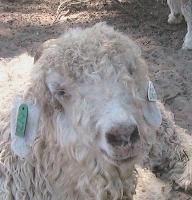| Fiber to Fabric |

| WASH & WEAR? Animals are usually not interested in staying clean, and their wool/mohair/fiber often contains dirt and natural oils. Depending on the fiber and the spinner's preferences, the spinner may choose to wash the fiber first or she may "spin it in the grease" (with the natural oils). Washing wool or mohair takes some care, as both of these fibers will mat and felt if the fiber is stirred around in the water. |
"Go ahead! Make my Day!" Sheep aren't always the sweet gentle creatures you read about in story books. White Ewe here is a VERY good mother and she'll protect her lambs from ANYTHING....including me. Her favorite pastime when she has young lambs is trying to ram me, even if I'm outside her pen. She has wonderful wool, though, and she always raises good lambs. |
| What does it take to turn fluffy wool into a piece of cloth? Follow the journey from fiber to fabric! |


| "HOLD ON A MINUTE!" Pan the Goat says. "All you're talking about is wool. We goats produce fiber, too!" Pan produces a tiny bit of cashmere, an extremely soft, downy undercoat that is used to make luxury garments. |

| Mama Victoria says, " Listen, this is very confusing. I'm an Angora goat, but my fiber is called MOHAIR. Angora fiber is produced by fluffy Angora rabbits! Camels, yaks, alpacas, and even cats and dogs produce hair and fiber that can be spun into thread." |


| Of course some fiber comes from plants. Cotton comes from the cotton plant. Linen comes from the flax plant. Flax has to be extensively processed to remove the long fibers from the stalk. Cotton has to be run through a gin to remove the seeds. |
| To understand wool, you need to know a little about sheep. There are literally hundreds of breeds of sheep in the world. Not all sheep are raised for their wool. Hair sheep lose their wool in the summer; they are raised for meat. |

| Jacob (right) is a Jacob Sheep, a primitive breed with up to 6 horns. Jacob has 4 horns. Jacob is a RAM. That means he's a boy sheep. Rams can be EXTREMELY dangerous animals and are one of the few farm animals that you really aren't supposed to try to tame. (They lose their fear of humans and will attack you more readily.) |
| A ewe, like White Ewe here, is a mother sheep. A baby sheep is called lamb. |
| Jacob is a pretty good boy, though. (Left) Here he is letting me shear him peacefully. He has wonderful wool that just shears from his body like a giant blanket. I use hand shears and shear the animals mostly standing up. We also have electric shears, but I don't use them that much. It takes me 1/2 hour or more to shear an animal. Professional shearers move the animal through 20 or more different positions (which requires a great deal of strength) and can clip an animal in 2 minutes or so. |